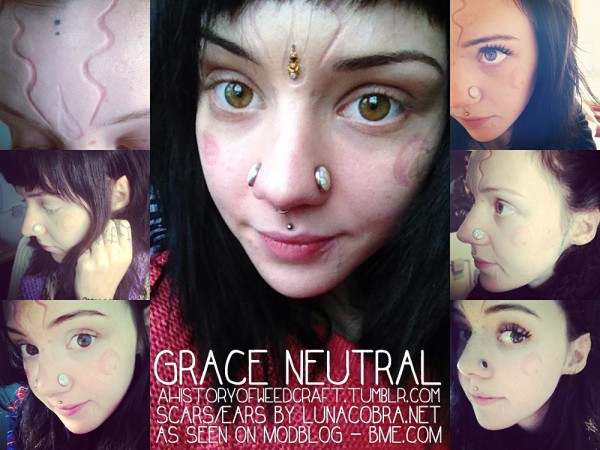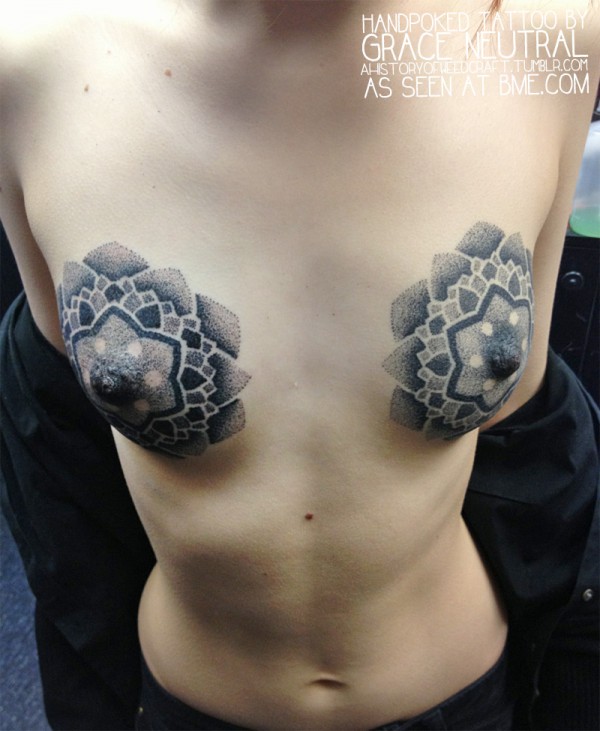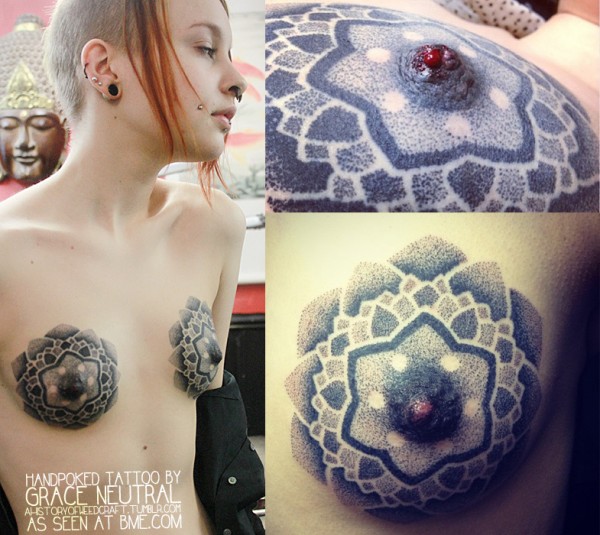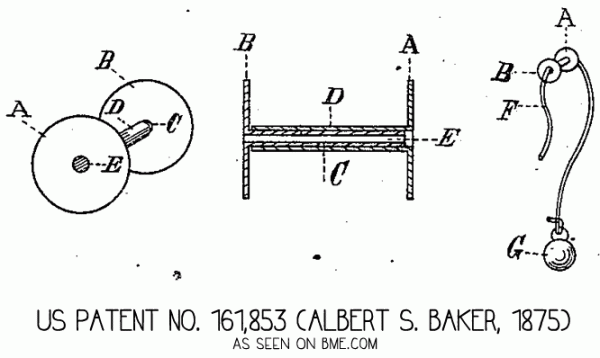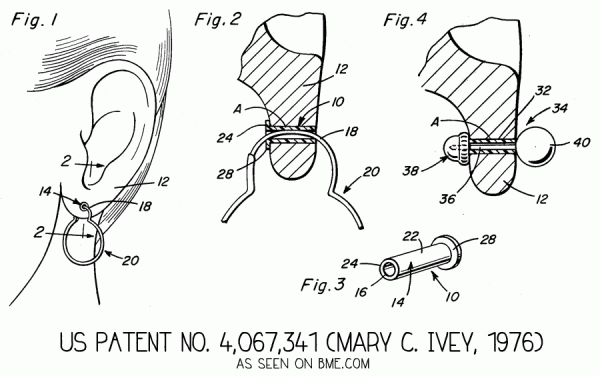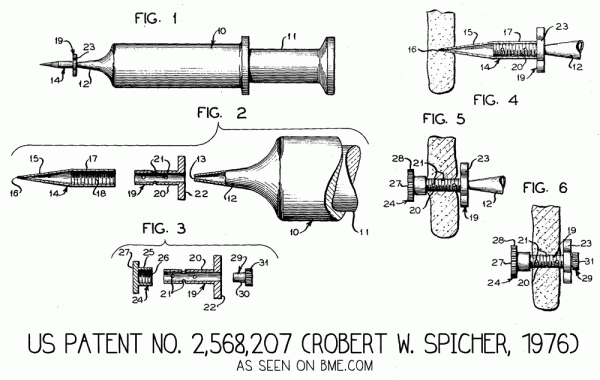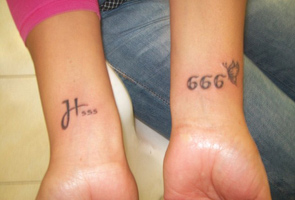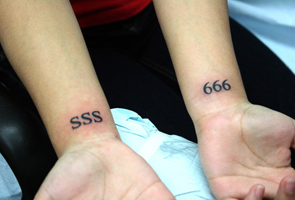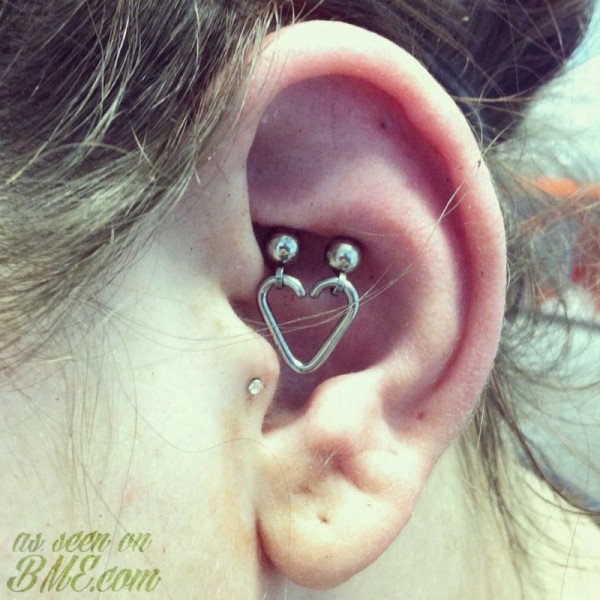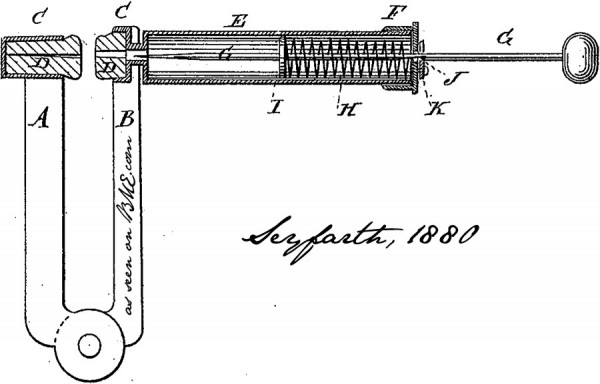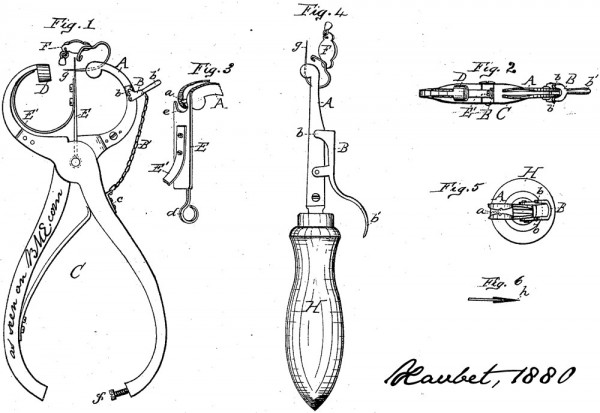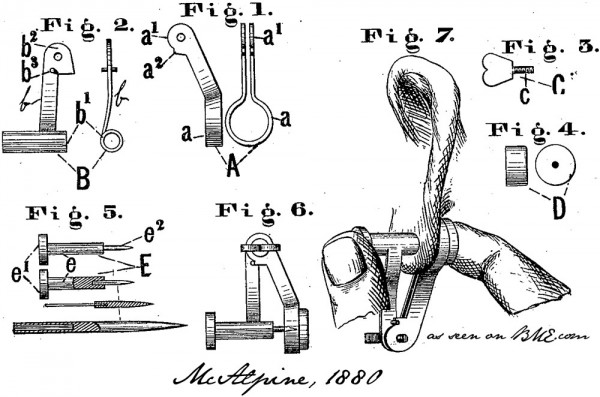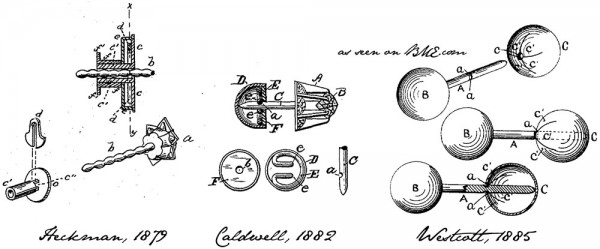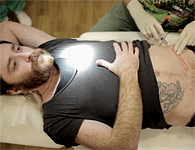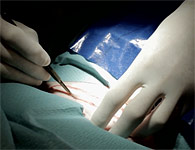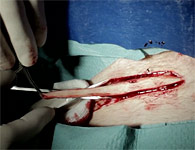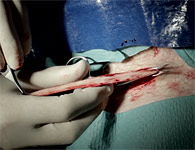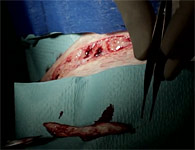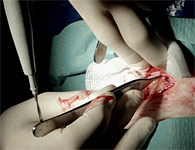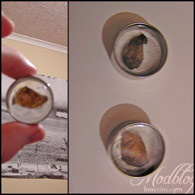Speaking of Grace Neutral (I just posted a great set of breast/nipple tattoos she did), I also wanted to update everyone on the amazing skin peel that Howie (lunacobra.net) did on her a while back. It’s healed now, and remains one of my all-time favorite facial scars, not just because of how technically well executed it is, but the unique design. It came about naturally over a few days of Grace and Howie talking about it, followed by drawing it up one night at the shop, tweaking it into perfection. With the ideal design on her face in marker, this is what they created. Her ear points are also Howie’s work by the way.
Yearly Archives: 2013
Post navigation
Handpoked Breast and Nipple Tattoos
Grace Neutral, a tattoo artist who specializes in handpoked work and is based in South London (although she travels regularly so don’t let that limit you — find her on Facebook or Tumblr) just did this incredible set of breast/nipple tattoos on Rebecka. Painwise, she tells me that the nipples hurt like crazy, but that it’s likely that doing them handpoked rather than grinding the ink in with a machine probably reduced the pain significantly. Click either picture for a bigger version.
Cutting through the air
As you know, I like seeing pieces that combine multiple body art disciplines, and I thought this was an elegant example of scarification used alongside tattooing, each artform contributing to the part of the design they’re best able to execute. Unlike many tattoo/scar combos, where the tattoos (or sometimes the scars) are added as an afterthought or “upgrade” long after the initial mod is well healed, this example was designed as such from the beginning. The scarification portion was performed by Binho Barduzzi of Familia Amorim Tattoo Shop in Lisbon, and the tattoo by was done by his friend Rafa. The piece is well healed now as it was cut back in 2009, so I wish I could show you a healed picture of it but unfortunately their client lives in Brazil, practically on the other side of the planet from them in Portugal.
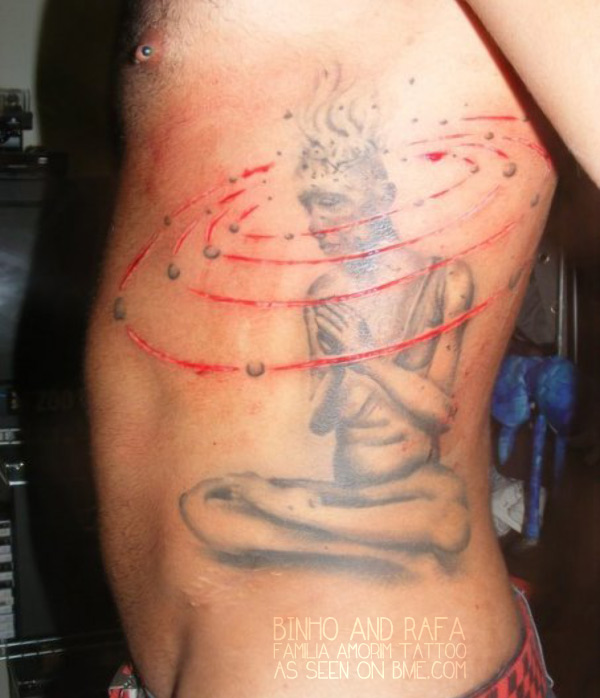
Early Ear Tunnel Design Precursors
I’ve sort of gotten hooked on reading these old patent records related to body modification, and just came across one that surprised me because of how ahead-of-its-time it was. In early 1875, Albert S. Baker of Somerville, MA filed a patent for what he called an “Imrpovement in Ear-rings” (US Patent #161,853). The patent is for a small gauge flanged tunnel to be worn in the earlobe — he explains,
“It is well known that in the use of ear-rings, as ordinarily constructed, the wires frequently tear out or cut the ear, and when not made of proper materials poison the parts with which they come in contact, thus sometimes causing great injury to the wearer. My invention is designed to obviate these difficulties and objections.”
He goes on to describe the device (which he calls a “spool” at times), which he instructs should be made of high quality gold, thus eliminating materials reactions such as nickel allergies. In addition, because the device is larger gauge than the fine wire that often makes up the hook of an earring, it reduces the chance of the jewelry pulling through. What, you thought Todd Bertrang was the first person to tell the world these things? Still, I was pleasantly surprised to see these concepts tossed around in detail nearly 140 years ago.
Many later jewelry designs also presented similar ideas (his appears to be the first hollow tunnel that was patented), but I will just very briefly mention another one of them, a patent filed in 1976 by Mary C. Ivey of Atlanta, GA (US Patent #4,067,341). Her concept is almost identical, and she explains it very similarly in her application, but adds that her design both allows the secondary jewelry more freedom to move due to the tunnel being larger, and also suggests taking advantage of advances that have been made in materials sciences (specifically plastics) to improve the design. Unfortunately she’s vague on many aspects (as is frustratingly common in patents) and does not however come out and say the actual diameter of the tunnel — as pictured I’m guessing in the realm of 8ga.
As you can see in those illustrations, the visual effect of someone wearing these tunnels — or “pierced earlobe protector” as Ms. Ivey titles it — is very, very close to someone wearing a small gauge tunnel of the sort we see all the time walking out the doors of your friendly neighborhood piercing studio. The one thing that neither Ivey nor Baker mention in their patents how the piercing is to be done, which I’m curious about, especially with Ivey’s, which seems to be getting too big to just shove into your average hole*. The only such insertion-method explanation I stumbled across regarding this style of jewelry was one filed in 1949 by Robert W. Spicher of Havre, MT (US Patent #2,568,207) for a “Surgical Piercing Device”.
The jewelry itself is superficially similar in design and intent to the others in this entry, but it also includes a sharpened taper that can be tightly fitted over the tunnel, either creating the new piercing hole or squeezing into an existing one, and then expanding that hole. The particularly creative part is that he then uses a syringe to blow air into the tunnel to make the taper pop off like a champagne cork — hopefully not shooting like a tiny bullet into the wearer’s neck! — to be replaced with a cap that keeps the tunnel from falling out.
______
* “that’s what she said”
Tattooing “666″ on a Baby
An incredibly disturbing video — probably the most offensive tattoo video to date — is currently doing the viral rounds. In it, the tattoo artist (whose face we never see), tattoos what appears to be a small “666″ on a toddler that screams in pain and terror while he’s doing it. A woman that I assume is the mother is holding the child down the whole time. Since there is parental consent in the process, it is 100% legal. Arguably this isn’t any worse than the doctors that have have cut off the ends of millions if not billions of baby boys’ penises to satisfy their parents religious or cultural leanings, and of course there are indigenous cultures (many of them idolized by the “modern primitive” movement) all around the world that do a wide variety of heavy mods on babies and children… But wow… I don’t think I could bring myself to be involved in something like this, either as the artist or the parent. But I wonder — how many of you who are willing to denounce this video are also willing to denounce the tribal cultures who do similar things in much larger quantities and to a more horrific extent, or even denounce circumcision which is still commonplace in America (although not many other Western nations at this point as the cruelty and needlessness is recognized)?
YouTube pulled the video — click here to download our backup or play it here:
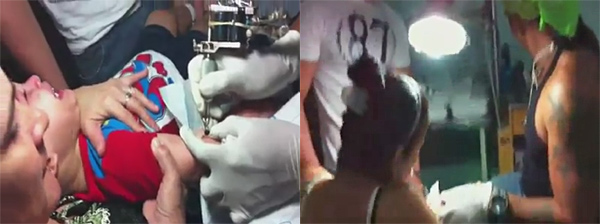
Update: If I had to guess [edit #2: this is now confirmed, and if you listen in the video you can hear them say that the child is now “blessed by Jesus”], I would say these people are followers of Jose Luis de Jesus of Growing in Grace. Followers of this fringe religion often get 666 tattooed one them as a part of their faith. The question is, do you believe in freedom of religion? Where is that line drawn for you? This group even has billboards around Toronto where I live — this isn’t just some isolated event. Below are some other similar tattoos done by their followers:
Update #2: Trying to find examples of tattooed children in Western culture, I was hoping to dig up an old story in BME’s old newspaper archive of historical mod stories because I remembered one about a father taking his identical twin sons to a tattoo artist in order to get a beauty mark tattooed on one of them as a way of telling them apart more easily. Anyway, I couldn’t find the actual article I was searching for, but I did find another from the October 19, 1899 Twin City News which mentions how an increasing number of parents are tattooing their children with a hidden ID mark (I believe this was in the midst of abduction paranoia).
Also, I mentioned above that the parents were “100%” legally in the right (although not ethically in my opinion), but I should point out that there have been cases — for example, this North Carolina mother arrested after allowing her 11-year-old to get a tattoo of a small heart on her shoulder — that suggest the opposite. However, courts in America are very unlikely to call the actions of an established religion “child abuse”, so don’t expect to see Jews being jailed over circumcision any time soon.
Mutated Hand
Here’s a great example of combining implants with tattoos. Hugo Ferreira of BIOTECH in Toulouse, France has taken some of Max Yampolskiy’s ring implants and put them into Noss’s hand, augmented with red tattoos that not only match the implants but his knuckles as well. I should add that the tattoos were there before the implant, making Hugo’s job much more difficult, but as you can see he lined them up beautifully.
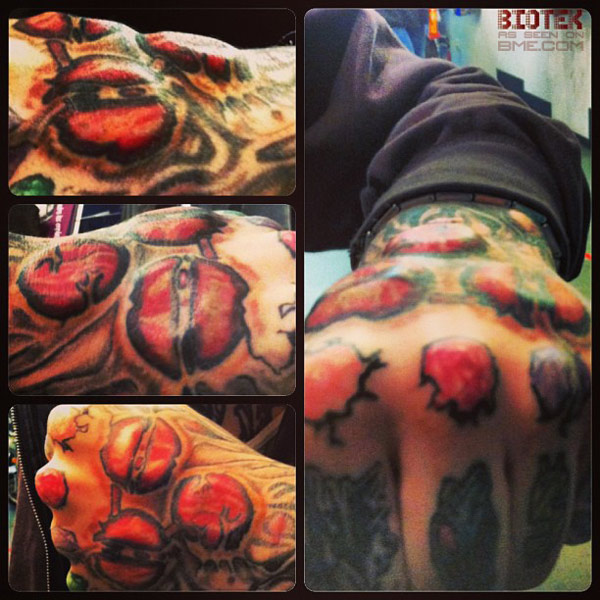
Alternative Heart Ear Method
Everyone has seen heart-shaped jewelry dropped into daiths over and over, but unfortunately not everyone who wants the look of a metal heart inside their ear has the anatomy to support a daith. Fathead came up with an interesting alternative, instead hanging the heart from a pair of inner conch piercings.
Ear Pointing via Genetic Engineering?
Recently I got into an interesting conversation with my friend Joseph about what unique mods could be done in his ear — that’s it on the left in the photo — since it has a slightly atypical shape, almost like a pointed ear. But what really blew my mind was when he showed me a picture of his brother’s ear (that’s it on the right), which has a similar but more pronounced atypical shape. Their younger brother apparently has a similar ear as well. The even stranger part of the story is that it only affects their left ears! So what do you think? Is there a gene that we could select for that would let people be born with pointed ears? Or do you agree with my sneaking suspicion that Joseph’s parents are mad scientists that have been doing experiments on their boys? It would explain their 400 IQ and ability to bench press a car. Either way, it’s pretty cool being born with naturally “modified” ears — how funny is it that they could probably show up at a tattoo convention and get people coming up and saying, “I love your ears? Who did the work?”
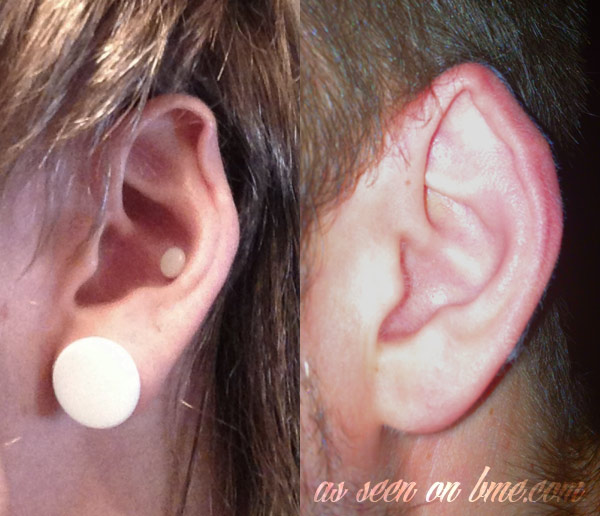
But seriously, I often think that genetic engineering is the future of human modification, once we get over our ethical hangups. It’ll never replace body modification of course because it completely removes the individual expression from the equation (since your genes are dictated by those who create you), but when it comes to really transforming ourselves, there’s not much that compares to genetic manipulation. Hell, it turned us from ape-like primates — from some sort of fish — from single-celled nothings — into the pinnacle of planetary dominance and destruction we are now. Don’t believe me? Ask Khan Noonien Singh! Bring on the Eugenics Wars! Create the Augments!
KHAAAAAAAAAAAANNNNNNN!!!
The Early History Of The Ear Piercing Gun
This morning I was reading old patents (yes, this is what I do for entertainment) and came across an interesting one from way back the last time piercing was überpopular over 130 years ago — filed May 10 and patented July 13, 1880 by Edward Seyfarth in Illinois (US Patent #240,073). As you can see, the design is not that much different from the piercing guns used by disease spreading hacks ^H^H^H^H nostril mutilating morons ^H^H^H^H I mean beauty salon “piercers” even to this day. The patent application reads in part,
“Be it known that I, Edward Seyfarth, of Lanark, in the county of Carroll and State of Illinois, have invented a new and useful Improvement in Ear-Piercers … The object of this invention is to furnish ear-piercers so constructed that the puncture can be made in exactly the desired spot and so quickly as to be painless … The invention consists in constructing an ear-piercer of a pair of bars hinged to each other at one end and provided at their other ends with sockets to receive blocks to be pressed against the ear, the tube having a cap upon its outer end, the needle having a disk and a notch, the spiral spring, and the catch for holding the needle when drawn out, so that the ear may be pierced while being compressed.”
“In using the piercer the blocks (D) are placed upon the opposite sides of the lobe of the ear in such a position that the hole through the blocks (D) will be directly over the spot where it is desired to puncture the ear. The arms (A and B) are then pressed together to numb the part of the ear between the blocks (D). The catch (K) is then drawn back to release the needle (G), which is forced forward to make the puncture by the elasticity of the spring (H), thus making the puncture without causing pain. The needle (G) is then drawn back, the instrument is removed from the ear, and a wire or thread passed through the puncture in the usual way.”
I’ve often heard the urban myth that the ear piercing gun is directly based on or evolved from the tool that places tags in animal ears — it wouldn’t surprise me if I’ve even written that at times. Even the extremely qualified and knowledgeable Elayne Angel says this in her recent book on the subject “The Piercing Bible” (which reminds me, check out her excellent piercing blog at that link), writing “these gadgets were originally invented for tagging cattle and other animals, and later adapted for use on humans”. But it seems this is a misleading statement, arguably false — at best the two tools co-evolved. More likely when we’re talking about piercing tools of the “gun” type that’s most common, one should more accurately argue the evolutionary process is actually the other way around, with a number of patents for animal tagging tools going to far as to explicitly refer back to this very ear-piercing gun patent by Edward Seyfarth! On the whole though I think it’s more realistic to say that the vast majority of animal tagging tools come from the same design family as modified pliers like riveting tools and leather punches, without that much overlap with the design of piercing guns (with a number of notable exceptions). But I’m beginning to digress.
Speaking of ear piercing guns that look more like animal tagging tools, there’s Francis X. Xavbet’s “ear piercing pliers” filed December 3rd, 1880 (US Patent #250,121 issued November 29, 1881), a simple clamp-like device. Xavbet’s design, unlike Seyfarth’s which only creates the hole, uses sharpened jewelry to accomplish the process in a single step as the tool places the ring. His patent reads in part,
“The object I have in view is to produce simple and convenient means for piercing ears, in which the ear-ring itself can be used as the piercing-point, and will be released by the instrument when the hole is formed, so as to remain in the ear till healed.”
“The ear-ring (F) … has a sharp-pointed wire (g). It is grasped by the clamp (A), in the position shown in Fig. 1, the plate (E) is then pushed toward the socket (D), and the lobe of the ear is introduced between such plate and the point of the ear-ring. The pliers are then forced together and the ear pierced, when the chain (B) draws back the dog (B) and the clamp is released. The instrument can now be removed from the ear and leave the ear-ring in position. The sharp point of the ear-ring can then be cut off; but this is not necessary, if the ear-ring is provided with a closed keeper, such as is used on safety pins.”
“When it is desired to place in the ears earrings not provided with sharpened points the removable cutting-points (h), Fig. 6, are used. These can be detached from the wires of the ear-rings after the holes are formed.”
I want to mention one other piercing tool that I dug up, filed just after the Seyfarth design by James McAlpine, on May 20, 1880 with the patent issued November 30th (US Patent #234,881). It deserves mention because it’s by far the simplest — not much more than a holder to help shove a short needle through the lobe with your thumb — he even suggests piercing both ears at once, as the tool is designed to be one-handed. The patent reads,
“The invention consists, mainly, in certain peculiarities of construction … [a] means of which the instrument is adapted for use with one hand, in consequence of which it is possible, by applying an instrument to each ear and operating them simultaneously, to pierce both ears at the same time.”
“The operation is substantially as follows: The jaws having been opened, the set-screw being loose, the bearing-faces may be adjusted to the lobe of the ear, and then be held in the proper position simply by tightening the set-screw. By means of the stop projection and pin the jaws are prevented from being brought together too closely. An instrument being thus attached to each ear, as indicated in Fig. 7, and the piercers being inserted in the tubes, the operator, by means of his thumb and finger, simply presses the piercer toward the button, in consequence of which the lobe is pierced. The hands being used simultaneously, both ears are pierced at once.”
“Some of the advantages are as follows: The use of two instruments at once for simultaneous action is desirable, because, first, a saving of time is effected, and, second, the pain and difficulty resulting from two distinct operations are avoided.”
The above designs are some of the earliest piercing tools of their respective families that I have been able to find to date — although I’m still searching and I strongly believe there are earlier ones in the patent archives that are still to be dug up. I don’t know for certain whether the first one is the earliest patent on a “true piercing gun” and whether Mr. Seyfarth can be credited as the concept’s overall inventor (I doubt it), but it’s certainly very early and you can still see its influence in ear piercing guns in use around the world.
As you may have noticed from these three Victorian patents, at this point there wasn’t a standardized design for the initial jewelry such as the ubiquitous butterfly-back that is still common today. However, browsing other early patents you start to see hints of this line of thinking, and definite precursors of designs that are still in use. From left to right below are US patents 216,954 (filed May 1, 1879 by Lois Heckman), 269,383 (May 8, 1882 by John Caldwell), and 320,991 (May 1, 1885 by Charles Westcott) — what is it with piercing inspiration and the month of May by the way?
All three of these designs use some variation on the backing lightly clamping into place on the bar, the first two being aesthetically closest to modern salon-style jewelry. The third one caught my eye though, because although it is functionally similar to the first two, visually it is identical to the barbell jewelry popularized in the body piercing world by Jim Ward in the 1970s…
When I have more time I will do additional patent research on this subject, both on the early history of body modification, and on some of the more recent patents, which have the advantage of being far more hilarious. For example, I was just reading a silly patent on a line of tongue piercing jewelry that contains a receptacle to release “a substance such as a chemical, breath freshener, pleasant flavor, or medication into the mouth of a wearer” (US Patents 6,675,613 and 8,006,516). The concept works just as you’d expect — a hollow bar to hold the substance, which is then released through holes in the beads. Anyone who has ever brushed plaque off of a tongue barbell can imagine just how disgusting this jewelry has the potential of becoming!!!
Skin Removal Scarification = Profit?
Australian Israeli-born and currently Iceland-based conceptual jeweler Sruli Recht — who tends to have a wonderful sci-fi aesthetic to his fashion and design that is less silly than much of the “far out” ideas too-often presented by his field — recently had a roughly 1/2″ by 4″ strip of skin cut off his belly which was then tanned and wrapped around a 24k gold ring, now being offered for a half million dollars. The somewhat grotesque design doesn’t just look like random leather — it’s even got wiry belly hair. He calls it the “Forget Me Knot”. Recht has lots of experience working with dubious organic materials — animal and fish remains including a stillborn lamb, hair, spider silk from a modified goat — but this is the first time he’s used human skin.
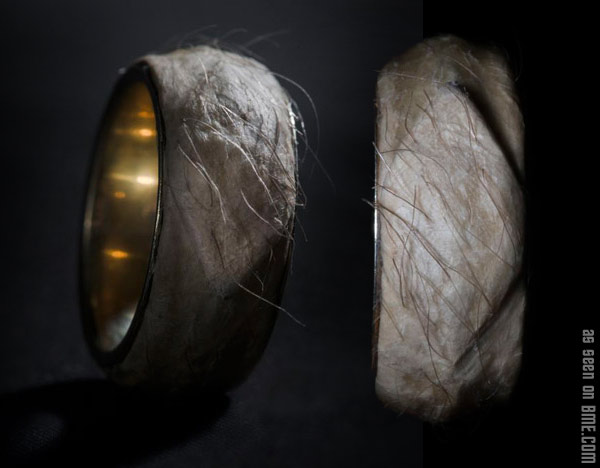
Here’s a graphic YouTube video of the procedure and some stills from it. The procedure is actually quite fascinating if you’re more used to the sort of skin removal scars done in the body modification world where the concern is the scar, rather than the excised tissue. You’ll see the doctor first spend a surprisingly long time anesthetizing the area, then cutting the outline using a scalpel, and then quickly cutting off the strip of skin using a pair of surgical scissors. Next you’ll see an interesting use of an electrocautery tool to stop small bleeders, where instead of applying the electrocautery tool to the wound itself, the vessels are pinched using tweezers, which are then electrified. Finally the wound is sutured closed.
Recht’s work is in a way another example of the “fine art” world catching up to and borrowing from the body modification world (Recht is no outsider though, and has tattoos as well as large gauge inner conch piercings), which has been using procedure remnants in jewelry for ages. Here are a few examples formerly featured on BME — a couple examples of removed nipples encased in cast acrylic resin (this seems to be a trend!), and a heart-shaped piece of human skin and cartilage inside a set of earplugs, also cast in clear resin. Below the pictures are a list of the previous entries that cover them in more detail.
- Nipple plugs #1: Mustache March and Guess What
- Nipple plugs #2: Grossest Plugs Ever
- Ear-heart plugs: Heart-shaped Ear Cartilage Preserved in Resin and Heart-shaped Cartilage Removal
PS. If anyone wants a strip of my belly skin — I have plenty of it, more than I need — I’ll sell it to you for a hell of a lot less than a half million dollars!
